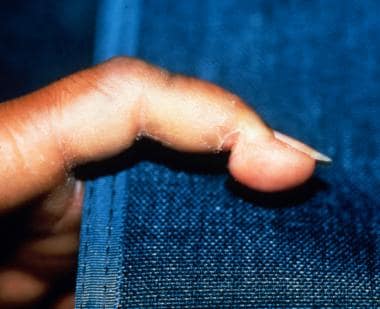Practice Essentials
Ainhum (dactylolysis spontanea) is a condition of idiopathic etiology involving a bandlike constriction of the soft tissue of a digit. Generally, the constriction presents bilaterally, with involvement of the fifth digit most commonly. Pseudoainhum is a similar condition that occurs as a secondary event resulting from certain hereditary and nonhereditary diseases that lead to annular constriction of digits.
Ainhum predominantly affects Black patients in tropical regions. Although it has been reported in temperate areas, ainhum appears to be increasingly less common in the United States. [1, 2]
The origin of the term ainhum is unclear. In 1867, the term was used by da Silva Lima [3] from Bahia, Brazil to report the first published case. The word ainhum means fissure in the language of the Nagos tribe of Brazil and may be related to ayun, the word for saw in the Lagos tribe of Nigeria.
Prognosis
Outcome is related to the stage in ainhum when the disease is diagnosed. Pain may be severe in ainhum and in pseudoainhum. Because ainhum occurs primarily in tropical areas, secondary infections and their complications may be a source of morbidity. Secondary infections may complicate ainhum. If more than just the bilateral fifth toes are affected in ainhum or pseudoainhum, the individual's balance may be affected when walking. Dermatophytosis complex may be a complication.
Causes
In 1952, Wells and Robinson [4] proposed 4 distinct sources of annular constrictions of the digits. The sources include (1) annular scarring from frostbite, burns, or trauma, (2) true ainhum, (3) constricting bands that simulate ainhum, and (4) congenital bands.
The exact etiology of true ainhum is unclear. Race and climate apparently are predisposing factors. Ainhum also may have a genetic component, since ainhum has been reported to occur within families. Infection and walking barefoot in childhood are linked to ainhum but probably are not major factors in its development. Abnormal scarring does not appear to be a cause; ainhum and keloid formation rarely occur in the same individual.
Treatment
No current treatment appears to halt the progression of ainhum, but therapy for ainhum in the early stages involves topical or injectable corticosteroids, salicylate preparations, or retinoids. Pseudoainhum may respond to treatment with etretinate. Reversal of pseudoainhum with acitretin has been described in a patient with associated Vohwinkel syndrome. [5] A literature review on pseudoainhum can be found in the International Journal of Dermatology. [6]
Definitive treatment for ainhum involves surgical intervention. See Surgical Care.
Patient education
Instructions in good foot care are critical. Since some cases of ainhum and pseudoainhum are familial, other family members may require examination.
Pathophysiology
In true ainhum, dactylolysis of a toe (most commonly, but not always, [7, 8] the fifth toe) most likely is triggered by trauma; however, the true cause remains unknown. The trauma may be related to walking barefoot in the tropics. A fibrotic band develops from a flexural groove and progressively constricts the full radius of the toe until spontaneous autoamputation occurs. A similar progression occurs in pseudoainhum because of a collagen band, rather than from fibrosis. Pseudoainhum may be acquired or congenital as discussed in a father and son case that described differing types of constricting bands. [9]
Ainhum most commonly affects the feet, but in rare instances it can affect the fingers, as shown in the image below. [10]
Epidemiology
Approximately 130 cases have been reported in the United States, but only about 30 cases have been reported since 1960. Pseudoainhum is a rare disorder. The highest incidence of ainhum appears to be reported among Black people of Africa, where the incidence range is 0.2-2%. The incidence of true ainhum outside of Africa appears to be low.
Ainhum is endemic in parts of Brazil, although an incidence has not been established. Brazilian cases of ainhum tend to occur in individuals with lighter skin color phenotypes due to a local history of interracial unions and offspring. [11]
Ainhum has been reported to affect all races but occurs most commonly in individuals of African, Asian, West Indian, North American, and Central American descent. No racial predilection exists for pseudoainhum. In Nigeria, a study revealed an incidence of 2.48 cases per 1000 males and 1.08 cases per 1000 females; however, recent investigations suggest no sex preference.
Full-blown ainhum is uncommon in persons younger than 30 years and older than 50 years. The reason ainhum appears to be age-specific is unclear. Early lesions may be observed in childhood.
-
Ainhum of the finger. Courtesy of Hon Pak, MD, and reviewed by Ross Levy, MD.






